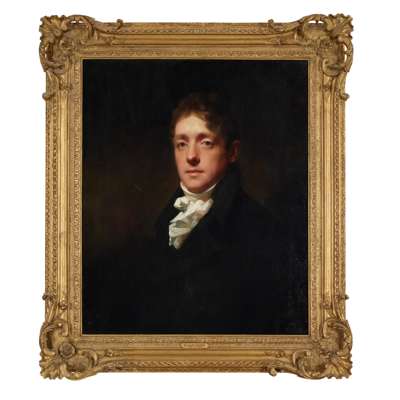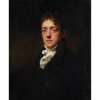
Lot 109

SIR HENRY RAEBURN R.A. (SCOTTISH 1756-1823)
HALF-LENGTH PORTRAIT OF MR WILLIAM MACKENZIE








Scottish Paintings & Sculpture
Auction: Evening Session | 7th December 2023 at 18:00
Description
Oil on canvas
Dimensions
76cm x 63.5cm (30in x 25in)
Provenance
Provenance:
William Mackenzie, Edinburgh
Acquired by descent to Miss E. G. Mackenzie, Pietermaritzburg, South Africa
Newhouse Galleries, New York
Mr. and Mrs. F. Howard Walsh, Fort Worth, Texas, 1966
Walsh Family Art Trust
Literature:
David Mackie, Sir Henry Raeburn Catalogue Raisonné, 6 volumes, unpublished manuscript, vol.III, pp. 642-643, no.505
Footnote
Exhibited: Durban Art Gallery, Natal, South Africa, "Treasures from Natal Homes", November 1959
Note: David Mackie makes reference to this portrait of William Mackenzie in his Henry Raeburn catalogue raisonné, having been supplied with a reproduction of the painting by the Newhouse Galleries, New York in 1988, and asserted that it appeared to be a late example of Raeburn's work. He does not make reference to the portrait of Mrs Mackenzie (Lot 108).
Henry Raeburn’s portraiture is intimate. It does not wholly subscribe to the formal Romantic mode widely practiced by his contemporaries, instead presenting its subjects with sensitivity, individuality and warmth. His sitters appear as if mid-gesture, mid-breath, emerging from the shadowy depths of their composition and advancing towards a light source located not far behind the viewer. This effect is achieved with deft, confident strokes of pigment: note, for example, the mark-making used to denote his gentleman sitters' cravats (see also: lot 107), almost daring in its abbreviation; this is an artist fully aware of his talent and how best to wield it.
While the soft light of the Mr Newbigging portrait (lot 107) is characteristic of Raeburn’s earlier painting, later in his career he lit his subjects more dramatically, such as we see in these portraits of Mr and Mrs Mackenzie. In heightening his tonal contrast, Raeburn could shroud landscape or interior settings (in which he had little interest) in shadow, instead directing the viewer’s attention, through glowing illumination, towards his subject’s face and gestures to subtly elucidate mood and expression and enhance the intimate atmosphere. Raeburn was nevertheless an Enlightenment man who held fundamental truth as his objective, and he approached portraiture with commensurate empiricism: throughout his career he insisted that his subjects sat before him so that he could compose their likeness directly onto the canvas, rather than working from preparatory drawings.
Raeburn is celebrated today as one of Scotland’s greatest artists, not least for his iconic oil of the ‘Skating Minister’ (Reverend Robert Walker Skating on Duddingston Loch, National Galleries of Scotland, NG 2112). Despite this, his beginnings in life were unassuming. Orphaned at a young age and fostered by his elder brother, the teenaged Raeburn seems to have first turned his hand to portraiture while apprenticed to an Edinburgh jeweller and goldsmith. He first produced miniatures, but within a matter of years he transitioned to oil painting. He worked from Edinburgh throughout his career, and by the end of his life was decorated with accolades, including an appointment as Painter and Limner to King George IV, alongside membership of the Royal Academy, Royal Society of Edinburgh and American Academy of Fine Arts.







